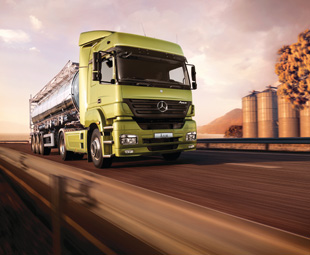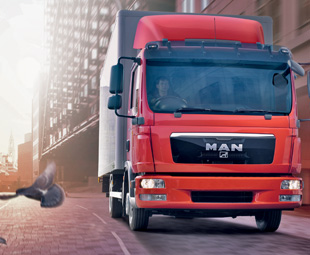Have the mighty fallen?

The transport industry of any country goes hand in hand with its economy, regardless of the nation’s developmental status, the strength of its currency or the time its government has been in existence. JACO DE KLERK takes a look at the effect the current eurozone crisis has had on that region’s commercial vehicle sector.
According to Matthias Wissmann, president of the German Association of the Automotive Industry (VDA), the commercial vehicle industry emerged stronger from the severe economic crisis of 2009, carrying around 75 percent of all freight traffic in Europe. “The last two years have seen a great recovery,” he says.
“In western Europe, sales of heavy commercial vehicles climbed to around 262 000 units in 2011, which was a 31 percent rise compared to that of the crisis year – 2009,” explains Wissmann. “The van markets, too, were back in their stride.”
He states that it wasn’t solely the markets that contributed to this development, with the commercial vehicle industry reaping the benefits of its hard work. “The trade has become even tougher, putting new products, leaner processes and even better services on offer. Manufacturers and suppliers have also become more efficient and more profitable.”
This year, however, conditions slumped back a bit and became somewhat rougher, with the commercial vehicle industry feeling the effects of the national debt crisis in some European countries. Luckily, the severely affected markets – Greece, Italy, Portugal and Spain – only account for around 15 percent of the entire continent’s sales volume.
Wissmann estimates that new registrations of heavy trucks with a gross vehicle mass (GVM) of six tonnes and above in western Europe will reach a total of anything between 250 000 and 256 000 units by the end of the year. “That would be a drop of two to four percent compared with last year,” he notes. “The sooner the finance markets can be stabilised, the faster the commercial vehicle markets will regain more dynamism.”
He advises looking beyond Europe, adding that the global market for trucks over six tonnes is likely to continue to expand for the rest of 2012, climbing by five percent to 3,27 million units globally.
“The US market is especially dynamic,” he says. “It is expected to increase by around 20 percent to 366 000 vehicles in 2012. This benefits in particular the German group brands, which have a market share of around 30 percent there.”
The markets in Russia, Japan and India also continue to expand. However, owing to the introduction of a new exhaust standard, Brazil is seeing a temporary fall in its figures. The VDA points out that there is still hope for Brazil, which has growth potential for the medium term.
China – the world’s largest commercial vehicle market, with units well in excess of one million a year – is having a break from its expansion this year with a three percent drop. “In the medium term, however, growth in China will continue,” says Wissmann.
“Against the background of the difficult economic situation in Europe, trends among the commercial vehicle makers are actually good and the result of hard work,” the VDA president emphasises. In 2011, German original equipment manufacturers increased their commercial vehicle production by just over 25 percent, with the rise rolling over to the first quarter of 2012, reaching a four percent growth for this period.
 However, as Wissmann points out, the heavy commercial vehicle (HCV) market is strongly driven by investments and is thus traditionally sensitive to economic trends. As he explains, sales of HCVs in Germany fell six percent in the first five months, while the volume of transport was increasing. The VDA therefore estimates that only a three percent fall in new registrations of HCVs will happen for the entire 2012.
However, as Wissmann points out, the heavy commercial vehicle (HCV) market is strongly driven by investments and is thus traditionally sensitive to economic trends. As he explains, sales of HCVs in Germany fell six percent in the first five months, while the volume of transport was increasing. The VDA therefore estimates that only a three percent fall in new registrations of HCVs will happen for the entire 2012.
New registrations of vans with a GVM of six tonnes and less will also decline at a three percent rate for the rest of 2012, which was its year-on-year fall from January to May this year. However, the German van market has expanded strongly in the two preceding years, by 16 and 18 percent respectively.
The VDA reports that German trailer and body manufacturers also had a very successful year in 2011, with the production of heavy semi-trailers almost doubling from 40 000 to around 76 000 units. In the first quarter of 2012, the companies more or less maintained their high level of exports and production, with 56 000 new HCV semi-trailer registrations expected to be reached by the end of this year.
Wissmann is optimistic: “In 2013, increasing dynamism may be expected once again – if the debt crisis has been overcome.” He adds that current forecasts suggest growth of 0,8 percent for the eurozone in 2013, which means the demand for commercial vehicles will also pick up. “The basic prospects are also good; the transport market remains a growth market. In Germany, road freight traffic will – according to the current medium-range forecast – rise by 3,3 percent every year up to 2015.”
He adds that this growth will only be possible with modern, fuel-efficient commercial vehicles and a high-performance transport infrastructure that can bring about efficient freight and passenger traffic. “Modern transport routes should therefore be made a policy focus for economic growth.”
Wissmann says the advantages of “CO2 champion” long-distance buses should be better utilised through the deregulation of long-distance routes. “In view of the high fuel prices in particular, buses offer a cheaper and greener alternative. Long distance buses could become Germany’s most socially positive form of long distance travel, if the politicians were to finally reduce the thicket of antiquated legal regulations and allow buses to operate long distance routes,” he explains.
The Passenger Transportation Act stipulates that new long-distance bus lines can only be added if they don’t compete with existing rail or bus lines – because Germany has a well-developed rail network to all major cities. This is a shame if one considers that local service buses emit an impressively low 75 g of CO2 per person for each kilometre travelled, as calculated by the German Federal Environment Agency.
“This means they emit less CO2 than trams, subways or the railways,” Wissmann points out, adding that buses are also particularly successful in the emerging economies, where metropolitan areas are growing quickly, demonstrating this transportation form’s unbeatable flexibility.
The world really has shrunk to the point where all economies are intertwined in some way or other. This was made abundantly clear when the globe felt the pinch of the US financial disaster of 2009, which played a major role in the current eurozone crisis. However, there is hope for both Europe and the world, as demonstrated by the birthplace of Western culture’s resilient commercial vehicle industry.
Published by
Focus on Transport
focusmagsa




 !
From 1 Apri
!
From 1 Apri

 Big news from FOCUS on Transport + Logist
Big news from FOCUS on Transport + Logist





 FUSO: Driving the Future of Mobile Healthc
FUSO: Driving the Future of Mobile Healthc



 A brand
A brand




 Wondering about the maximum legal load for a
Wondering about the maximum legal load for a 
 The MAN hTGX powered by a hydrogen combus
The MAN hTGX powered by a hydrogen combus

 Exciting News for South African Operators
Exciting News for South African Operators
